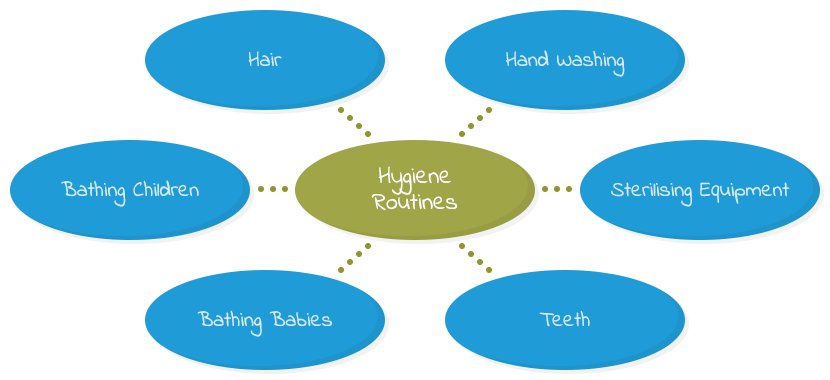Hygiene routines
Young children can often get ill because of infections. Germs in the environment cause infections, and when children pass germs between themselves, this is called cross infection. One of the best ways to prevent this is through good hygiene routines. This just means making sure things are clean!
There are lots of different ways that hygiene routines can prevent illness and infection. Click through the mind-map below to learn more.
Hand washing
Washing your hands, and making sure that older children regularly wash their hands, is one of the best ways to reduce the risk of cross infection. You should make sure that you, and any children, wash their hands properly before they eat or drink, after they use the toilet, and after playing outside or touching animals. As well as this, if children have been playing with dough, water or paint, they should also wash their hands.
When working with babies, you should make sure to wash your hands before and after preparing feeds, and before and after changing nappies.
Sterilising equipment
When working with babies in particular, it’s important to sterilise equipment used for feeding. This involves washing any feeding or changing equipment in hot soapy water after use, and there may be other steps you need to take, depending on the items you are sterilising. You can learn more about the proper sterilisation process for baby bottles here if you’d like to do some further research.
Teeth
At around 6 months of age, babies will start to get their first teeth. Gently brushing these teeth with a soft brush at least twice a day is recommended, and this should continue throughout childhood. As children get older, you can start to teach them to brush their own teeth, but it is still important to supervise this so that you can make sure they are doing it properly! If children eat too many sugary foods, or don’t clean their teeth properly, this can lead to tooth decay. It is therefore very important to make teeth cleaning a part of a child’s hygiene routine.
Bathing babies
Bathing babies is important for their hygiene, but it also helps their physical and cognitive development as they splash around and – as they get older – play with toys in the bath. Although bath time can be fun for babies, it can also be quite dangerous. It is important never to leave a baby alone near or in water, and to make sure the temperature of the water is no more than 38 degrees Celsius.
You will also need to have clean clothes, a towel, a bin for waste materials and a clean nappy ready before you begin to remove a baby’s clothes and support them in the bath. It’s very important that the baby doesn’t get too cold! Before you bath a baby, you should remove their nappy and clean them as you would at any nappy change before bathing. You’ll learn more about this on the next page. After this, you should gently wash the baby with sensitive shampoo and body wash, before rinsing them and drying them carefully. Once this is complete, you should quickly put a clean nappy on the baby, and dress them to make sure they don’t get cold.
Bathing children
As children get older, they are more able to bath themselves. Children should never be left unattended in the bath or shower, and it is important that a parent is always there to make sure they clean themselves properly. Many children have bath time at the end of the day, but it is still important to make sure children wash their face and hands first thing in the morning! Using a gentle or sensitive body wash and shampoo is a good idea, as children’s skin can be very sensitive.
Hair
Taking care of children’s hair can be relatively simple. Babies require gentle hair brushing with a soft brush once a day, and it’s important to check with parents exactly what their preferences are. With children, it’s also important to brush their hair carefully once a day to remove tangles. However, as children get older you also have to look out for head lice! These are small parasites that live in children’s hair, and are easily passed between children. If you do find any, make sure to let a supervisor or parent know so that they can arrange treatment and get rid of the lice. There are lots of different types of hair and skin. Always talk to parents to find out about individual hair and skin care.
Did you know?
Lots of children don’t like getting their hair brushed. A good tip is to give a child a doll with hair, so that they can brush the doll’s hair while they are having their own hair brushed! This helps the child to feel involved in the process, and keeps them preoccupied while you get out any tangles.
You’re doing really well! Let’s move on to learn about toilet routines!

